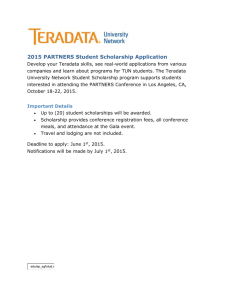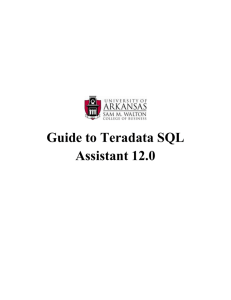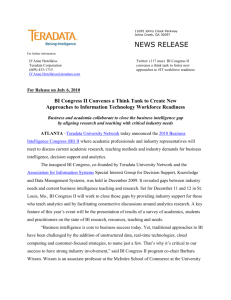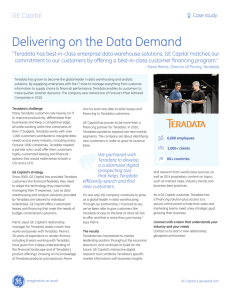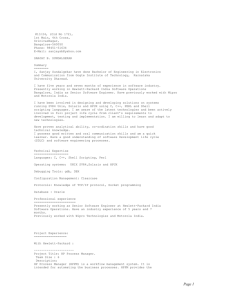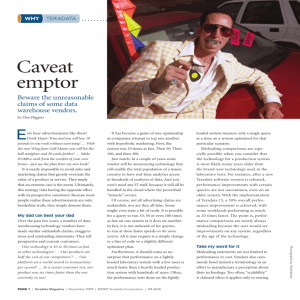2. Data Governance - Teradata's Approach
advertisement
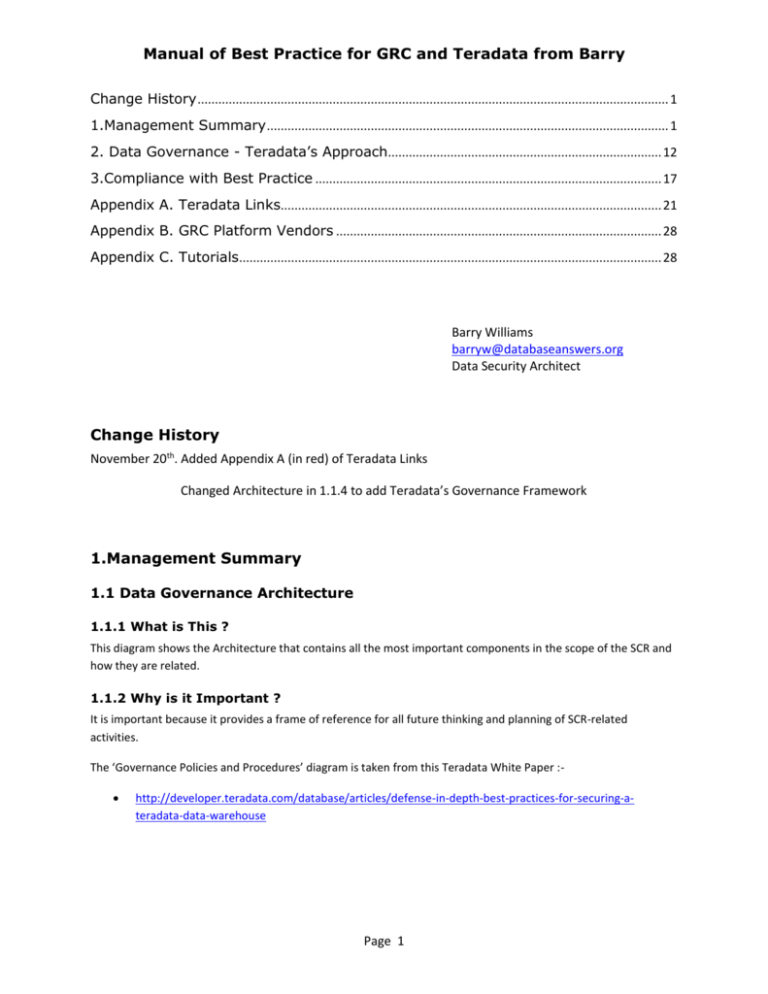
Manual of Best Practice for GRC and Teradata from Barry Change History ........................................................................................................................................ 1 1.Management Summary .................................................................................................................... 1 2. Data Governance - Teradata’s Approach............................................................................... 12 3.Compliance with Best Practice .................................................................................................... 17 Appendix A. Teradata Links.............................................................................................................. 21 Appendix B. GRC Platform Vendors .............................................................................................. 28 Appendix C. Tutorials.......................................................................................................................... 28 Barry Williams barryw@databaseanswers.org Data Security Architect Change History November 20th. Added Appendix A (in red) of Teradata Links Changed Architecture in 1.1.4 to add Teradata’s Governance Framework 1.Management Summary 1.1 Data Governance Architecture 1.1.1 What is This ? This diagram shows the Architecture that contains all the most important components in the scope of the SCR and how they are related. 1.1.2 Why is it Important ? It is important because it provides a frame of reference for all future thinking and planning of SCR-related activities. The ‘Governance Policies and Procedures’ diagram is taken from this Teradata White Paper : http://developer.teradata.com/database/articles/defense-in-depth-best-practices-for-securing-ateradata-data-warehouse Page 1 Manual of Best Practice for GRC and Teradata from Barry 1.1.3 Data Governance Architecture – the Philips version Philips favours a three-tier Architecture with Governance, Risk Management and Compliance (which includes Governance) :1. 2. 3. Governance Risk Management (which includes Teradata’s Best Practice for securing a Data Warehouse) Compliance (which includes Governance) Security (Threats, Defenses, etc.) Risk Management – (Risks, Threats and Safeguards –see 1.1.4 below) Data Extract Data Integration Data Warehouse User Access Layer Best Practice for Securing a Teradata Data Warehouse Compliance (Policies and Procedures, Data Lineage, Sarbanes-Oxley,etc.) also Governance (Roles and responsibilities, User Profiles, Data Access, etc) Page 2 BI Layer Manual of Best Practice for GRC and Teradata from Barry 1.1.4 Data Governance Architecture plus Teradata’s Data Governance Framework Security / Governance (Teradata’s Data Governance Framework) Risk Management – (Teradata’s Risks, Threats and Safeguards) Teradata’s Best Practice for Securing a Data Warehouse Page 3 Manual of Best Practice for GRC and Teradata from Barry Compliance (Statutory Requirements, Best Practice, Sarbanes-Oxley, Data Lineage, etc.) Page 4 Manual of Best Practice for GRC and Teradata from Barry 1.1.5 Teradata Risks, Threats and Safeguards This diagram is taken from this document entitled “Security Features in Teradata Database” : http://www.teradata.com/WorkArea/linkit.aspx?LinkIdentifier=id&ItemID=17948&libID=17931 Page 5 Manual of Best Practice for GRC and Teradata from Barry 1.2 Risk Assessment 1.2.1 What is This ? This is a table that can be used to carry out an ‘As-Is’ Risk Assessment of an organisation in relation to its SCR activities. 1.2.2 Why is it Important ? It is important because it establishes the starting-point for all SCR planning activities. It can be used on a regular basis to establish a long-term goal and to track progress towards the goal. An organisation can carry out a Self-Assessment along the following lines to determine whether they are at the level of Basic, Intermediate and Advanced. Automation Governance Risk Compliance Roles and Responsibilities Threats / Defenses Policies and Procedures Basic Intermediate Advanced Status at Philips No automati on Partially automated Automated Top to Bottom Partial-ISC None None ? Data Warehouse Scripts None Yes Integrated Some ? Master Data Management None Yes Integrated Some ? Sensitive Data Yes None ? Unauthorised Access Yes None ? Best Practice for a Data Warehouse In place Data Lineage No Data Models Yes Some ? External Standards compliant No None ? Page 6 Data Dictionary None ? Integrated None ? Manual of Best Practice for GRC and Teradata from Barry Statutory Requirements (eg Sarbanes-Oxley) Maybe None ? ‘?’ means that something is in place but the scale and adequacy are to be confirmed. In summary, we can say that the situation at Philips is basic, with partial development in progress but no overall coherent strategy planned or in place. 1.3 Risk Monitoring System 1.3.1 What is This ? A Risk Monitoring System is an automated approach to tracking all the Risks in the environment. The future will be a mixture of automated and manual Governance procedures. A number of Key Risk Indicators (‘KRIs’) will have been identified and Dashboards produced regularly. The Key Risk Indicators (KRIs) will be maintained in a KRI Register which will be updated regularly. 1.3.2 Why is it Important ? The Risk Monitoring System is important because it helps us understand what does the future will look like and track progress in a controlled manner. The Risk Monitoring System can either be developed internally or purchased from an external vendor or a mixture of both. Engaging with a vendor has the advantage of ‘free consulting’ regarding the state-of-the-art, and what is possible. This diagram can be discussed with vendors and those that show no understanding can be dropped to the bottom of the list of potential suppliers. Situation Reports KRI Dashboard Feedback Key Risk Indicators (’KRIs’) Risk Monitoring System GRC Platform Data Extract (eg Log Files) Page 7 Manual of Best Practice for GRC and Teradata from Barry 1.3.3 Teradata Facilties Teradata offers facilities that are very useful for Governance Audit in a Risk Monitoring System. The Teradata Database automatically audits all successful and failed user logon attempts in the Event Log. An authorised Security Administrator can then search and sort logon/logoff records using SQL statement to query a defined system view. 1.4 Risk Factors to be monitored 1.4.1 Phase 1 This diagram shows In Red the Risk Factors that might be monitored in Phase 1 of a Proof-ofConcept. They are all related to User Activity and use data from the Teradata Database Log file. User Authentication Data Extract Data Integration User Access Layer User Online Activity Data Warehouse Current Activities Page 8 Data Marts BI Layer Manual of Best Practice for GRC and Teradata from Barry 1.4.2 Later Phases This Data Migration Framework for Best Practice shows In Red Indicators for Phase 1 of the POC, and Green for later Phases. Compliance (Data Lineage) Sensitive Data (Encryption) User Sessions Data Modelling (DDL Scripts) (Data Lineage) Data Extract Data Integration Master Data Management (‘Single View of the Truth’) User Access Layer Data Warehouse Data Consistency (SQL Scripts) Unsuccessful Login Attempts GRC Factor :Name of Risk/Threat Description Operational /Financial Impact Defense/Response Status Who is responsible ? How many occurrences ? Page 9 BI Layer Publish and Subscribe Manual of Best Practice for GRC and Teradata from Barry 1.4.3 Mobile Security Risks This Section is included as a starting-point for discussion of corporate-specific considerations. This Diagram is taken from this page on the Microsoft Technet Web Site : http://technet.microsoft.com/en-us/library/cc182262.aspx It shows possible security threats to a corporate network that supports mobile devices. 1.4.4 Cloud Security Risks This Section is included for future requirements. This table shows what Best Practice suggests for the activities that relate to Cloud Security Risks. Cyber and Physical Security Application Security Platform Security Support for LDAP and SSO Password Management Policies Intrusion detect ion Operational Readiness System Audits Monitoring Independent audits of security control Continuous monitoring of logs and alerts Well-defined Incident management and escalation process Page 10 Manual of Best Practice for GRC and Teradata from Barry 1.5 Data Model This Data Model for GRC is taken from our Database Answers web Site : http://www.databaseanswers.org/data_models/governance_risk_mgt_compliance_GRC/index.htm It is important because ir can be used to assess potential software solutions to meet the GRC requirements. Page 11 Manual of Best Practice for GRC and Teradata from Barry 2. Data Governance - Teradata’s Approach 2.1 What is This ? Data Governance is concerned with Roles and Responsibilities. 2.2 Why is it Important ? It is important because it establishes how well an organisation can be sure that critical procedures are performed in an acceptable manner. 2.3 Discussion 2.3.1 Data Governance Standards Approval Process This diagram is from this page on the Teradata Web Site: http://apps.teradata.com//tdmo/v07n02/Tech2Tech/InsidersWarehouse/StrengthIngovernance.aspx Page 12 Manual of Best Practice for GRC and Teradata from Barry 2.3.2 Establishing a Data Governance Program This step-by-step procedure is taken from the web link given above :> Identify the "owners" of the data assets. > Create an oversight committee. > Develop a policy that specifies who is accountable for the data's accuracy, accessibility, consistency, completeness and updating. > Define processes on how the data is to be stored, archived, backed up and protected from mishaps, theft or attack. > Establish a set of standards and procedures that defines how the data is to be used by authorized personnel. > Implement controls and audit procedures for ongoing compliance, company mandates and government regulations. Page 13 Manual of Best Practice for GRC and Teradata from Barry 2.3.3 Governance Hierarchies The following two diagrams are taken from this page on the Teradata Web Site : http://apps.teradata.com//tdmo/v08n01/FactsAndFun/Services/TeamWorks.aspx The two pyramids in Figure 1 show different approaches to governance. The left pyramid is driven by Corporate Governance, while the pyramid on the right is driven by Data Governance. The Data Governance must, of course, be consistent with the Corporate Governance. The two pyramids show different approaches to governance. The left pyramid is driven by corporate governance, while the pyramid on the right is driven by data governance. 2.3.4 Data Governance Framework The sections of the framework in figure 2 show the various functions within data governance. Page 14 Manual of Best Practice for GRC and Teradata from Barry Page 15 Manual of Best Practice for GRC and Teradata from Barry 2.3.5 Data Governance Pyramid The three primary levels of Data Governance Accountability are : The Enterprise Information Governance Steering Committee The Data Governance Council Data Stewardship Team Page 16 Manual of Best Practice for GRC and Teradata from Barry 3.Compliance with Best Practice 3.1 Data Models 3.1.1 What is This ? This section provides guidance on the different kinds of Logical Data Models that can be associated with a Data Warehouse. 3.1.2 Why is it Important ? It is important because it provides guidance on how to determine if a particular set of Data Models complies with industry Best Practice. The material is taken from this page on the Database Answers Web Site : http://www.databaseanswers.org/data_models/types_of_data_models/index.htm Page 17 Manual of Best Practice for GRC and Teradata from Barry 3.1.3 Discussion In summary, there are five distinct types of Logical Data Models : BI Layer Semantic Model Data Marts / Dimensional Models (Star and Snowflake) Data Warehouse (Third Normal Form) Staging Area/Operational Data Store (ODS) Models This list can be used as a Template to carry out an Assessment of a specific Modelling situation in an organisation. In addition, there are some Rules that can be applied, for example, a Semantic Model should be defined on a Logical Data Model and not on a Physical Data Model. This is because a Physical Model is likely to change and be denormalised from time to time to achieve improved performance, especially in a Teradata environment. This makes Physical Models inappropriate as a foundation for Semantic Models which are intended for business users and must be stable. 3.2 Data Quality 3.2.1 What is This ? This section discusses Data Quality and how it can be improved to the standards necessary. 3.2.2 Why is it Important ? It is important because Data Quality has a serious and adverse affect on business operations around the world. The material is taken from this article on the Teradata Magazine : http://teradatamagazine.com/v11n03/tech2tech/cut-out-bad-data/ Page 18 Manual of Best Practice for GRC and Teradata from Barry 3.2.3 Teradata Data Quality Improvement Model This diagram shows the Teradata Data Quality Improvement Model which features a Data Quality Scorecard :- 3.2.4 Teradata Data Management Architecture This diagram shows how these Tools from Teradata can be used to address and improve Data Quality problems : ADS Generator Data Profiler Data Quality Rules Manager Master Data Management Metadata Services Viewpoint Warehouse Miner These tools can be integrated with third-party tools. Page 19 Manual of Best Practice for GRC and Teradata from Barry 3.2.5 Teradata Best Practice Teradata has defined two procedures for Data Quality Best Practice : Seven Steps to Data Quality Compliance How to set up a Data Quality solution in a four-week Proof-of-Concept The combination of Teradata Warehouse Miner tools and Data Quality Rules Management (DQRM) provide a Data Quality solution tailored for a Teradata Data Warehouse. Page 20 Manual of Best Practice for GRC and Teradata from Barry Appendix A. Teradata Links This Appendix lists a number of very useful Teradata Links, some of which are repeated elsewhere for convenience. Some of these are articles are written by Jim Browning, the Enterprise Security Architect at Teradata, who is an excellent writer. Others are links to one-hour Online Training Courses, which cost $195 each. Teradata Blogs are a valuable source of peer-group information : http://www.teradata.com/blogs/ A.1 Best Practices This is a link to a one-hour Online Training Course by Jim Browning on Best Practices for securing a Teradata Data Warehouse : http://developer.teradata.com/database/training/defense-in-depth-best-practices-for-securing-ateradata-data-warehouse A.2 Data Governance This is a link to a one-hour Online Training Course on the What and Why of Data Governance : http://developer.teradata.com/general/training/data-governance-what-is-it-why-you-need-it It covers data security, data quality, data integration, data architecture, metadata and steps to a build a data governance program. A.3 DBQL Query Tracking This article in Carrie’s Blog explains how DBQLog is used to track Database performance : http://developer.teradata.com/blog/carrie/2012/07/intrepreting-dbql-delaytime-in-teradata-13-10 Page 21 Manual of Best Practice for GRC and Teradata from Barry A.4 Encryption This is a link to a one-hour Online Training Course by Jim Browning on How to use Encryption in Teradata : http://developer.teradata.com/database/training/now-you-see-it-now-you-cant-how-to-useencryption-in-teradata-systems A.5 LDAP and SSO This is Part 2 of two articles by Jim Browning entitled ‘User Authentication made Simple’ : http://developer.teradata.com/database/training/teradata-security-part-2 A.6 LDAP and SSO – De-Mystifying This is a link to a one-hour Online Training Course by Jim Browning : http://developer.teradata.com/database/training/de-mystifying-ldap-and-sso-teradatadatabase-external-authentication It provides an overview of the steps required to configure the Teradata Generic Security Services subsystem (TDGSS) to work with an LDAP infrastructure and configure Kerberos to support SSO. A.7 Query Banding for Security Views This is a very useful article (because it provides detailed syntax example) in the Applications group in the Developer Exchange : http://developer.teradata.com/applications/reference/using-teradata-query-banding-tohandle-security-views A.8 Securing Network Access This is Part 1 of two articles article by Jim Browning. It covers TDGSS Security Architecture, Using Authentication, Password Controls and Encryption : http://developer.teradata.com/database/training/teradata-security-part-1 Page 22 Manual of Best Practice for GRC and Teradata from Barry A.9 Semantic Layers This is a one hour Training Course that discusses Semantic Layers and complex views and how Teradata executes them. This helps to avoid complex views that are problematic : http://developer.teradata.com/database/training/how-to-design-complex-views A.10 Solving the Data Management Challenge Teradata also calls this “A Self-Assessment Data Governance procedure” but it doesn’t seem to live up to that billing : http://www.teradata.com/resources/brochures/Solving-the-Data-Management-Challenge-eb5427/?type=BR A.11 Supply Chain Risk Management This is a very interesting article that demonstrates the quality of Teradata’s thinking :- . http://www.teradata.com/resources/white-papers/Making-Supply-Chain-Risk-Management-Part-of-Your-CoreManagement-Process-eb5030/ A.12 Teradata Blogs Teradata Blogs are a valuable source of peer-group information : http://www.teradata.com/blogs/ A.13 Teradata Database Overview This overview explains what makes Teradata different from other databases and makes it possible for Teradata to deliver unlimited scalability in every dimension, high performance and simple management http://developer.teradata.com/database/training/teradata-database-architecture-overview A.14 Teradata Disaster Recovery This is an interesting Blog by Darryl McDonald. However, the link to the Disaster Recovery Plan is disappointing :- http://blogs.teradata.com/darryl-mcdonald/a-disaster-doesnt-have-to-be-a-disaster/ Page 23 Manual of Best Practice for GRC and Teradata from Barry A.15 Teradata Enterprise Reference Architecture This is another example of Teradata’s thinking : http://www.teradata.com/web-seminars/enterprise-reference-architecture/ A.16 Teradata in the Clouds This Developer Exchange article explains in detail how to set up your own Teradata 14 facility running in Amazon’s EC2 Cloud : http://developer.teradata.com/database/articles/teradata-express-14-0-for-ec2-config-guide A.17 Teradata Risk Program Implementation Methodology Teradata has developed its own approach to a Methodology for managing Risk. It is described on this article : http://www.teradata.com/resources/brochures/Solving-the-Data-Management-Challengeeb5427/?type=BR This diagram shows their Data Management Topology :- Page 24 Manual of Best Practice for GRC and Teradata from Barry A.18 Teradata and SAP SOA Teradata and SAP have collaborated on a Service-Oriented Architecture : http://apps.teradata.com//tdmo/v07n03/Tech2Tech/AppliedSolutions/BlueprintForTheNextLevel.aspx A.19 Teradata View of Architecture and Models Teradata considers that of Architecture and Models are vitally important to the success of a Data Warehouse. An extract of their views from this article is shown below : http://www.teradata.com/resources/brochures/Solving-the-Data-Management-Challenge-eb5427/?type=BR 1. Build a flexible, scalable architecture. Over time, you will want to add more data, users and subjects, so pay attention to the architecture. A data warehouse architecture (and Page 25 Manual of Best Practice for GRC and Teradata from Barry data management architecture) that’s flexible and scalable will allow for ord erly evolution instead of growth by assimilation. 2. Implement a vibrant enterprise model. Integrated enterprise modeling (both logical and physical) is critical to a data warehouse’s design and alignment to business needs. The model determines how business and IT will define, use, view, update and maintain data. Don’t constrain the data warehouse’s evolution with a data model that imposes inflexible assumptions about the business, fails to allow for new subject areas or is unable to provide a foundation for insight And this diagram shows their Risk Program Implementation Methodology :- A.20 Teradata Wallet for Password Management The Teradata Wallet was introduced in Teradata Tools and Utilities 14.00 and offers state-of-the-art facilities for managing Passwords : http://developer.teradata.com/tools/articles/introducing-teradata-wallet It uses the the tdwallet utility and can be used with LDAP. Page 26 Manual of Best Practice for GRC and Teradata from Barry A.21 Third-Party Online Training This is worth checking out for price and quality and whether it is available for Release 14 : http://www.onlineinformaticatraining.com/online-teradata-training/ A.22 User Authentication This is Part 1 of two articles by Jim Browning covering User Authentication, LDAP and SSO : http://developer.teradata.com/database/training/teradata-security-part-1 A.23 Viewpoint Viewpoint is a Teradata BI-type front-end that can display Dashboards using permissions are role based. It is most widely used to monitor the performance of a Teradata Database, such as CPU Utilization. This is a Starters-Guide to Dashboards. : http://developer.teradata.com/viewpoint/articles/a-starters-guide-to-portlets-and-dashboards A.24 Viewpoint - Getting Started This Blog entry is called “Raising Intelligence - Viewpoint Learning to Learn” : http://developer.teradata.com/blog/gryback/2010/01/raising-intelligence-viewpoint-learning-to-learn A.25 Viewpoint – Security Model This is an article in Developer Exchange : http://developer.teradata.com/viewpoint/reference/viewpoint-portlet-security/domainspermissions-and-resources It describes conceptually how the Viewpoint Security Model is based on these concepts : Domain Permission Dependency Resource Page 27 Manual of Best Practice for GRC and Teradata from Barry Appendix B. GRC Platform Vendors B.1 Acuity Risk Management GRC We downloaded free trial on Tuesday, November 20th. – irritating procedure. UK-based in Regent Street, London, from this page :– http://www.acuityrm.com/ B.2 Optial From this page : http://www.optial.com/Solutions.aspx B.3 GRC Tools There is a List of Tools and useful commentary - http://www.grc-resource.com/?page_id=16 B.4 SAP From this page : http://scn.sap.com/docs/DOC-8879 Appendix C. Tutorials C.1 Scope – Road Map This Road Map shows the major Components, especially as they relate to Governance, Risk and Compliance :- Page 28 Manual of Best Practice for GRC and Teradata from Barry Governance (Roles and responsibilities, User Profiles, Data Access, etc) Data Extract Data Integration Data Warehouse Data Marts User Access Layer BI Layer Data Quality Teradata-specific material is shown in red. C.2 (Data) Governance This Road Map shows the major Components, especially as they relate to Governance, Risk and A one-hour Online Training Course on the What and Why of Data Governance is available :* http://developer.teradata.com/general/training/data-governance-what-is-it-why-you-need-it C.3 Data Quality Data Quality is closely related to Compliance with Best Practice which specifies that procedures should be in place to ensure good quality data and that checks should be run on a regular basis to identify and correct any quality problems. Teradata offers a Training Course on Data Quality : http://developer.teradata.com/general/training/ten-practical-steps-for-building-data-quality-into-your-data C.3.1 Teradata’s Seven Steps to Data quality Compliance This material is taken from an article in the Teradata Magazine : http://teradatamagazine.com/v11n03/tech2tech/cut-out-bad-data/ Page 29 Manual of Best Practice for GRC and Teradata from Barry This illustrates how to use two Teradata Tools to explore a typical Business rule that ‘the value of a Customer Order should never be negative’ : The Data Quality Rules Manager (DQRM) The Data Warehouse Miner’s Profiler The seven Steps are as follows :1. Connect to the Teradata system containing the data. 2. Create a new (or open an existing) project to hold the analyses that the data steward wishes to create for data exploration should never be negative”. 3. Add at least one analysis to the project. For example, pick a Teradata Profiler Frequency Analysis. 4. Configure the analysis by picking the tables and column of interest—age or date of birth—from the drop-down menu. 5. Set any non-default output options or configure a Where clause, such as "Order Value < 0." 6. Execute the analysis using the run icon. 7. Examine, interpret and use the results. The Data Steward can repeat steps 3-7 for any data quality question he or she wishes to ask, either as a prelude to entry in DQRM or as a follow-up to rules violations reported by that tool. C.3.2 Teradata’s DQ Proof-of-Concept Here’s how to set up a data quality solution in a four-week Proof-of-Concept (POC): Follow POC data quality business rules: Identify key data stewards and IT users Document 10 representative data quality business rules Implement the rules Populate the data quality rules data model with all 10 rules Test the rules Create a POC environment: Acquire Teradata Data Quality Rules Manager (DQRM) and Teradata Warehouse Miner’s Teradata Profiler Install the software Produce data quality reports and scorecard: Identify and design 10 data quality reports and scorecard Configure the reporting tool to produce the reports and scorecard Implement and test them Implement a knowledge transfer: Develop documentation on the rules, reports and scorecard Deliver knowledge transfer onto Teradata Profiler and DQRM for data stewards and IT users Page 30
